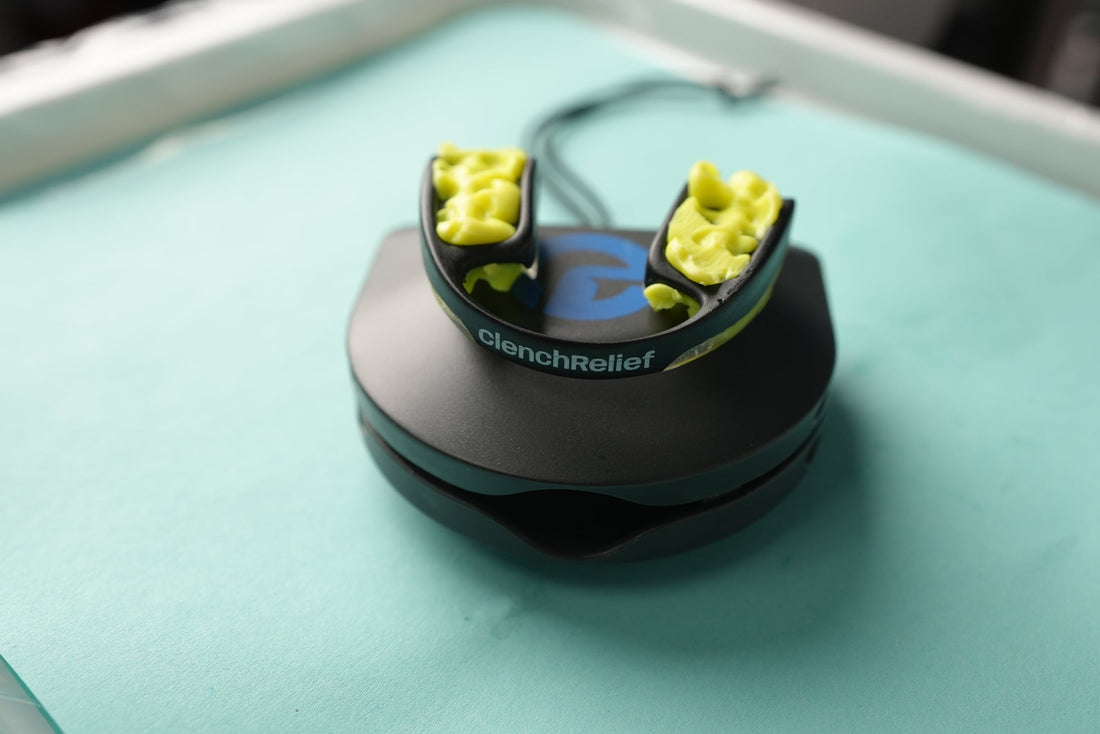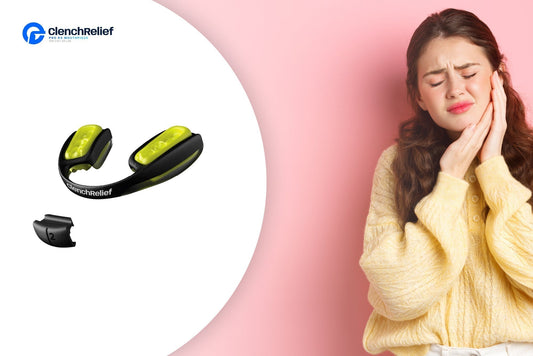
Mouthguard Care and Maintenance: Tips To Prevent Odor, Discoloration, and Discomfort
Table of Contents
- Why Mouthguards Turn Yellow or Smell
- Clench Relief® Pro Rx TMJ Mouthpiece Cleaning Tips: How To Clean Your Device
- Fixing Dry Mouth and Loose Fit
- Keeping It Clean Between Uses: Best Storage Practices for TMJ Devices
- Keep Your Mouthpiece Clean, So It Can Keep You Protected
Mouthguards, nightguards, mouthpieces and splints can protect teeth, ease jaw tension, and prevent damage from grinding, but without proper care, they can start to smell, discolor, or lose their fit.
If yours is turning yellow or slipping out at night, it can worsen your symptoms. Poor maintenance can lead to more jaw tension, disrupted sleep, and even more intense discomfort, especially for anyone managing TMJ pain.
Use these mouthguard care and maintenance tips to keep your device clean and comfortable to help you feel better.
Why Mouthguards Turn Yellow or Smell
Does your nightguard look yellow or have an odd smell? Bacteria and buildup are likely to blame. Understanding the causes can help you prevent bigger problems down the line.
Yellowing often comes from:
- Dried saliva that sticks to the surface over time
- Plaque buildup that’s not fully cleaned off after each use
- Bacteria settling into minor scratches or grooves
- Heat exposure—like hot water or being left in a warm car—which can change both color and shape
Odors tend to develop when:
- Food particles or proteins in saliva get trapped in the material
- Bacteria multiply inside enclosed, moist environments (like a sealed case)
- The guard isn’t fully dry before storage, encouraging microbial growth
A reliable care routine can help prevent mouthguard odors and bacteria while keeping yellowing to a minimum.
Clench Relief® Pro Rx TMJ Mouthpiece Cleaning Tips: How To Clean Your Device
If your mouthpiece spends the day on the counter or just gets a quick rinse before bed, germs are likely piling up. Cleaning it properly doesn’t take much time, but consistency keeps it clean, fresh, and safe to wear.
Follow this daily cleaning routine to keep your TMJ appliance in good condition:
- Rinse immediately. Use lukewarm water to rinse off saliva and debris as soon as you remove the mouthpiece. This prevents buildup from drying on the surface and keeps bacteria from settling in.
- Brush gently. Use a soft-bristled toothbrush to clean all surfaces. Stick to water or a non-abrasive toothpaste—gritty formulas can scratch the material and give bacteria more places to hide.
- Use mild soap. Apply a small amount of clear, unscented hand or dish soap to help break down oils and residue. Avoid dyes or fragrances that could irritate your mouth or damage the device.
- Dry completely. After rinsing, let the device air dry on a clean towel or in a ventilated case. Trapped moisture promotes bacterial growth and leads to faster odor and discoloration.
- Skip harsh products. Never use hot water, bleach, or alcohol-based mouthwashes. These can warp the shape, break down materials, and reduce the lifespan of your nightguard or splint.
Following these steps keeps buildup and odors in check while helping your mouthpiece last longer and work better.
Fixing Dry Mouth and Loose Fit
Waking up with a dry mouth? Your nightguard might be the reason. Some materials reduce saliva flow, especially if the device covers too much of the palate or doesn’t fit precisely around your teeth and gums.
Try these dry mouth solutions for guard wearers:
- Drink more water during the day to support saliva flow at night.
- Use a humidifier in your bedroom to keep airways and mouth from drying out.
- Apply a saliva substitute before bed if your mouth feels dry overnight.
- Switch to a custom-fitted guard that doesn’t block the palate.
- Replace guards that fall out regularly (they may be too worn out to stay secure).
If those steps don’t solve the issue, ask your dentist to check the fit or recommend an alternative. A device like the Clench Relief® Pro Rx Mouthpiece stays in place comfortably thanks to its BPA-free, medical-grade PVS material—reducing bulk and minimizing dry mouth at the same time.
Keeping It Clean Between Uses: Best Storage Practices for TMJ Devices
How you store your mouthpiece matters just as much as cleaning it. A damp, closed case invites bacteria, odors, and even warping. Always let it air dry completely before putting it away.
Here’s how to keep it in good shape, extend the life of your mouthpiece, and keep it safe to wear night after night:
- Store it in the ventilated case that came with it, allowing airflow while keeping dust out.
- Keep it out of heat—avoid direct sunlight, hot cars, or warm water that can distort the shape.
- Clean the case regularly to avoid transferring bacteria back onto the guard.
- Check your device every few weeks for signs of wear, cracks, or buildup that regular cleaning might miss.
Keep Your Mouthpiece Clean, So It Can Keep You Protected
A clean, secure mouthpiece does more than protect your teeth. It helps ease TMJ pain, lower tension, and let you sleep without constant discomfort. With the right care, your mouthguard can be a reliable part of your routine and help you feel like yourself again.
Try the Clench Relief® Pro Rx Mouthpiece. It’s a high-quality, at-home option built for comfort, stability, and lasting relief.



